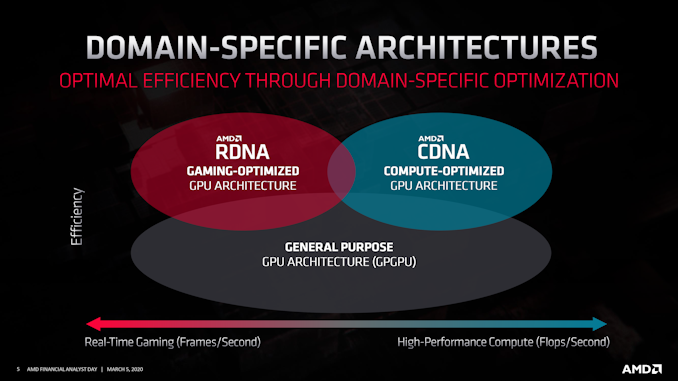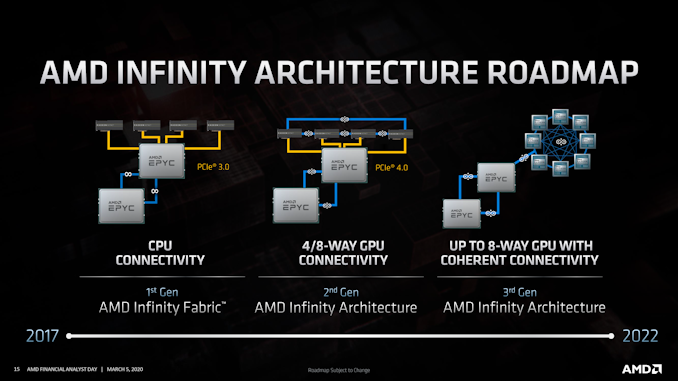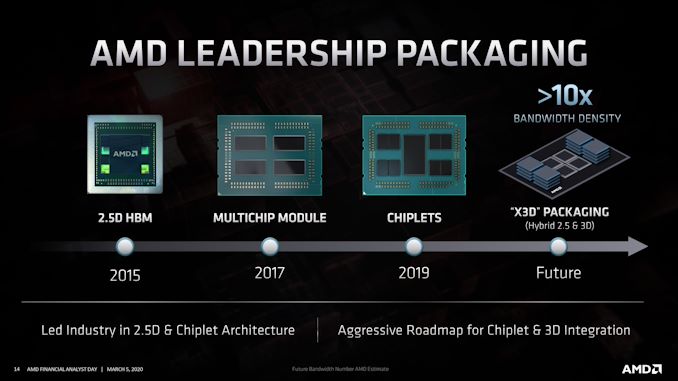- Jun 1, 2017
- 5,248
- 8,463
- 136
You may be aware AnandTech posted a lot of articles about the AMD Financial Analyst Day 2020. A lot of details were discussion which I think deserve a dedicated thread. I'll keep updating the OP while going through them. Done
 www.anandtech.com
www.anandtech.com
 www.anandtech.com
www.anandtech.com
AMD no longer references 7nm+, so the connection to TSMC's N7+ is no longer a given.

 www.anandtech.com
www.anandtech.com
In place of the current Vega for computing in the server market CDNA will come as counterpart to RDNA for consumers.

 www.anandtech.com
www.anandtech.com
To cover the increasing scope of Infinity Fabric it's being renamed to Infinity Architecture.

 www.anandtech.com
www.anandtech.com
AMD teased X3D packaging as a successor to the current chiplets MCM packaging in an unspecified future.

 www.anandtech.com
www.anandtech.com
AMD shipped 260 million Zen cores by 2020. Ian Cutress pixel counted the graph and came up with these numbers: 2017-2018: ~30m cores, 2018-2019: 80m cores (~110m total), 2019-2020: 150m cores (~260m total)
Note of caution: This is cores, not chips. So with up to 64 cores per chip this number looks more impressive than it would otherwise. For comparison, alone through sales of PS4 an Xbox One there are far more than 1.2 billion Jaguar cores in the wild. So we can expect the numbers of Zen cores to vastly increase further once the new Zen 2 based consoles launch later this year.
 www.anandtech.com
www.anandtech.com
 www.anandtech.com
www.anandtech.com
RDNA 2 is called Navi 2X, further improves perf per watt and includes hardware ray tracing.
 www.anandtech.com
www.anandtech.com
Zen 3 based Milan coming in ‘late 2020’, Zen 4 based is coming out by 2022.So the cadence is more to the 15 months than 12 months side. Zen 3 will hit the consumer market ‘later this year’.
AnandTech Forums: Technology, Hardware, Software, and Deals
Seeking answers? Join the AnandTech community: where nearly half-a-million members share solutions and discuss the latest tech.
AnandTech Forums: Technology, Hardware, Software, and Deals
Seeking answers? Join the AnandTech community: where nearly half-a-million members share solutions and discuss the latest tech.
AMD no longer references 7nm+, so the connection to TSMC's N7+ is no longer a given.

AnandTech Forums: Technology, Hardware, Software, and Deals
Seeking answers? Join the AnandTech community: where nearly half-a-million members share solutions and discuss the latest tech.
In place of the current Vega for computing in the server market CDNA will come as counterpart to RDNA for consumers.

AnandTech Forums: Technology, Hardware, Software, and Deals
Seeking answers? Join the AnandTech community: where nearly half-a-million members share solutions and discuss the latest tech.
To cover the increasing scope of Infinity Fabric it's being renamed to Infinity Architecture.

AnandTech Forums: Technology, Hardware, Software, and Deals
Seeking answers? Join the AnandTech community: where nearly half-a-million members share solutions and discuss the latest tech.
AMD teased X3D packaging as a successor to the current chiplets MCM packaging in an unspecified future.

AnandTech Forums: Technology, Hardware, Software, and Deals
Seeking answers? Join the AnandTech community: where nearly half-a-million members share solutions and discuss the latest tech.
AMD shipped 260 million Zen cores by 2020. Ian Cutress pixel counted the graph and came up with these numbers: 2017-2018: ~30m cores, 2018-2019: 80m cores (~110m total), 2019-2020: 150m cores (~260m total)
Note of caution: This is cores, not chips. So with up to 64 cores per chip this number looks more impressive than it would otherwise. For comparison, alone through sales of PS4 an Xbox One there are far more than 1.2 billion Jaguar cores in the wild. So we can expect the numbers of Zen cores to vastly increase further once the new Zen 2 based consoles launch later this year.
AnandTech Forums: Technology, Hardware, Software, and Deals
Seeking answers? Join the AnandTech community: where nearly half-a-million members share solutions and discuss the latest tech.
AnandTech Forums: Technology, Hardware, Software, and Deals
Seeking answers? Join the AnandTech community: where nearly half-a-million members share solutions and discuss the latest tech.
RDNA 2 is called Navi 2X, further improves perf per watt and includes hardware ray tracing.
AnandTech Forums: Technology, Hardware, Software, and Deals
Seeking answers? Join the AnandTech community: where nearly half-a-million members share solutions and discuss the latest tech.
Zen 3 based Milan coming in ‘late 2020’, Zen 4 based is coming out by 2022.So the cadence is more to the 15 months than 12 months side. Zen 3 will hit the consumer market ‘later this year’.
Last edited:



